
|
Dehydration Dehydration and Heat Exhaustion are the greatest health hazards that you are likely to encounter on hikes in the Santa Barbara area. The city of Santa Barbara may look like a tropical paradise but if you reach into the ground you will pull up plastic hosing that makes the illusion of paradise work. In actual fact, we live in a very arid area and you need to protect yourself by carrying plenty of water with you when hiking. The amount of water varies greatly depending on the time of year and the trail conditions. An exposed hike on a fire road can be twenty or thirty degrees hotter than a trail under cover of trees near a stream. I've been told by a physical therapist who used to lead hikes for the Sierra Club that you should drink about one mouthful of water every ten minutes because that is about how much your body looses in perspiration in that time. Bottom line, never underestimate Santa Barbara's arid nature. When you need it most, you won't be able to reach into the ground and pull out pipes full of water on the trail.
|
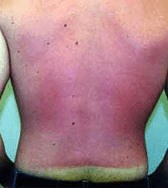
|
Ultraviolet People from the north and east of the United States are surprised at the intensity of the sun and that they get sunburned so easily in Santa Barbara. Check the Ultraviolet index in the local paper and you will find that the UV index in our area is often high or very high. You should wear a hat and sunscreen rated at 30 or more to protect yourself. Beyond the threat of sunburn the intensity of the sun can make the most seasoned hikers melt in the sun like the cake in MacArthur's Park. Bring plenty of water and a salty snack. Seak out as much shade as possible on the hike even if it is only partial shade. You will never cool down by sitting in the sun and you will be exposing yourself to unnecessary ultraviolet rays..
|
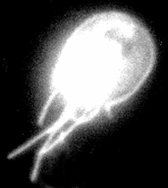
|
Giardia Giardia intestinalis is a microscopic protozoan that causes debilitating intestinal distress. Most people carry water filters on backpacking trips to filter these germs out of the water. An estimated 4,600 cases of Giardia are reported each year. Most of those cases however, are not hikers but are people exposed through community swimming pools and infected municipal water supplies. The germ has been found in small concentrations (less than 20% of samples) in many backcountry lakes and streams. A recent study found that these water supplies are often infected by large mammals, most often horses. If you are anywhere near horse trails, cattle or other large mammals be sure to filter the water. The good news is that your body will eventually fight off the Giardia and you will most probably have some immunity the next time you run into it.
|
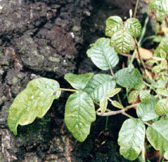
|
Poison Oak Poison Oak, Toxicodendron diversilobum, contains an oil called urushiol which has the unluckly ability to set off the human immune system. Some people are more sensitive to it than others but as with any immune reaction the more the exposure the stronger your body's reaction to it will be. I used to be able to pull poison oak out with my bare hands and now can get a rash through my pants without direct contact. The good news is that the oil that causes the reaction is not on the surface of the poison oak plant so you can't get it unless the plant is broken or disturbed. The bad news is that almost all poison oak next to popular trails has been disturbed. Dogs will often get poison oak on their fur and then rub up against you thereby transfering the oils to you. You have about five to ten minutes to wash the oil off before it bonds with your skin. If you get a severe case, dermatologists have creams that can stop it in its tracks but only if you apply it before the skin is damaged.
|
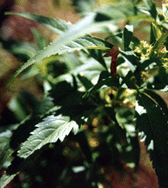
|
Stinging Nettles Stinging Nettles, Urtica dioica, grow in stream beds so that is the only place that you will see them. In the spring these plants have tinying needles or hairs with an irritating, numbing chemical that can be extremely painful. The pain and numbness usually go away in a couple of hours. I seem to be especially sensitive to them because it usually takes two or three days for my pain to be relieved. Late in the fall, the needles have fallen off and they are not as dangerous as they were earlier in the year.Interesting to note that in Europe these leaves are gathered, soaked in water to remove the needles and poison, and then eaten as a gourmet treat.
|
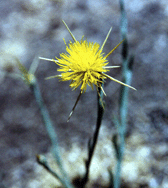
|
Star Thistle Star Thistle, Centaurea solstitialis, is a noxious weed that was introduced to California by the '49 gold miners. It has nasty needles that poke at your ankles and legs. Only chaps can keep them from puncturing your skin. Many trails in the backcountry are now infested with these weeds and it is almost impossible to eradicate them. Many of the native plants also have spines and stickers that tear at your flesh as well. This is why it is strongly advised that you don't try to go cross country in the Santa Barbara and Los Padres areas. We have seen many people get torn up so much that their legs look like raw hamburger.
|
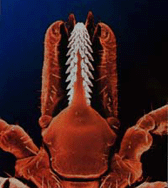
|
Western blacklegged tick This tick, Ixodes pacificus, is only one of the species of ticks in the Santa Barbara area but they carry several organisms that cause disease in humans. The deer tick can carry the agent for Lyme disease which is caused by a spirochete bacteria called Borrelia bugdorferi. Lyme disease has been reported in the Los Padres Forest behind Santa Barbara and Ventura. One friend who hikes with us often was infected. The tick goes through three stages and it is the adult stage that feeds on large mammals such as deer and occassionally humans. Ticks are most active in the early spring in the Santa Barbara area. Often you can see them perched on the tips of weeds or blades of grass waiting for a free ride. Ticks cannot fly or jump so they sit with their front legs extended and grab a ride from whatever animal rubs up against them. The good news is that they will no start feeding immediately but rather will crawl to a safe location before feeding so you have time to wipe them off. In springtime, in wet areas, it is a good idea to stop every so often for a 'tick check' with your fellow hikers.
|
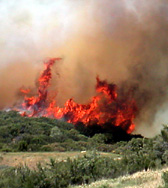
|
Wild Fire You are unlikely to be personally threatened by wild fire but you are highly likely to be effected by it in the Santa Barbara area. We share an arid environment with plants that have adapted by producing stiff dense wood loaded with oils. Add the fact that we don't get enough rain for mold and rot to decay the wood when it dies and you have an ever increasing load of fuel building up. Fire is the natural way to return the elements in the dead wood to the earth but had naively restrained fire from doing its job. Now some areas have not burned in 50 to 100 years. The recent Cachuma Incident is evidence of what may happen. The danger of wild fire is one that is most often caused by human carelessness or maliciousness.
|
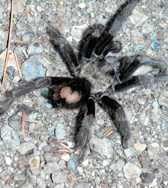
|
Tarantulas Despite all the horror movies you have seen, Tarantulas have never killed anyone and are in fact quite gentle. If they do bite, it is often compared to a bee sting in severity. In the Santa Barabara backcountry they are commonly seen on late afternoons in the fall crossing roads and trails. The ones you see are the males in search of a mate. Males have a smaller, narrower abdomen than the females. Sometimes you will see a male with bald spots like this one. They will rub hairs off their abdomen and throw them at attackers. The hairs are very irritating. Hikers have often let the Tarantulas walk across their hands or have picked them up briefly. None have ever been bit. Tarantulas eat small pests so they are beneficial to man and should not be killed. There is an old Chumash legend that the first rains will come ten days after Tarantulas are seen seeking a mate.
|
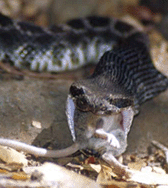
|
Rattlesnakes The western rattlesnake is fairly common on the trails of Santa Barbara. This picture of a rattlesnake swallowing a mouse was taken by Diane Soini on a hike we did up to Three Pools. I have seen dozens of them in my years of hiking. Others, who stay to the heavily used popular trails have never seen one. For the most part, the western rattlesnake is not aggressive and will avoid people at all costs. The poisonous venom that they carry is needed for their feeding so they are not thrilled about having to use it on a non-edible object like your leg. I often joke that when we pass a rattler on a group hike that the first person gets hissed at, the second person hears the rattle, and the third person is the one that gets bit. There is some truth in this, although we have never had the third person get bit. An emergency room doctor who hikes with us often says that "90% of the rattlesnake bites that they see happen to males between the ages of 13 and 29 with alcohol on their breath and bites on their hands." Hike sober, don't try to pick up snakes, stand back when you hear the rattle and you should be okay.
|
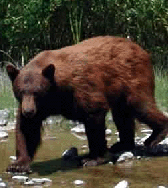
|
Black Bear Whether black, brown, cinnamon, or buff colored they are all black bears. It is highly unlikely that you will see a black bear in your travels through the back country. They are very shy. This picture was taken by Jim Childress on the Sisquoc River. He was down wind of the bear whod didn't notice him. The Los Padres bears avoid people unlike the spoiled bears you hear about in the high Sierra that hang out at parking lots and are such a nuisance. Incidentally, that bear you see on the California State flag is a grizzly bear. The last California grizzly bear was killed in 1922. I've heard that black bears are not native to this area and were brought in to replace the grizzlies. If you do happen to run into a bear, keep a respectful distance and don't try to approach it. Chances are very good that he will run off if you give him a chance.
|
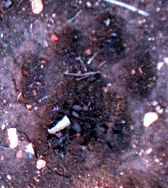
|
Mountain Lion You are more likely to see a mountain lion print than a lion since they usually avoid humans. I saw this print on the Santa Cruz Fire Road and have seen many others in the backcountry. To reduce the chance of encountering a lion you can: Avoid hiking alone, especially between dusk and dawn, when lions normally do their hunting. Make plenty of noise while you hike so as to reduce the chances of surprising a lion. Always keep children in sight while hiking and within arm's reach in areas that can conceal a lion. Mountain Lions seem to be drawn to children. Hike with a good walking stick; this can be useful in warding off a lion. Keep in mind that a mountain lion attack is extremely rare. You are ten times as likely to be killed by our family dog or a neighbor's dog. The chance of an attack is not zero though. Two people have been attacked in the Santa Barbara area and although both were several years ago, there have been recent sightings in our area.
|